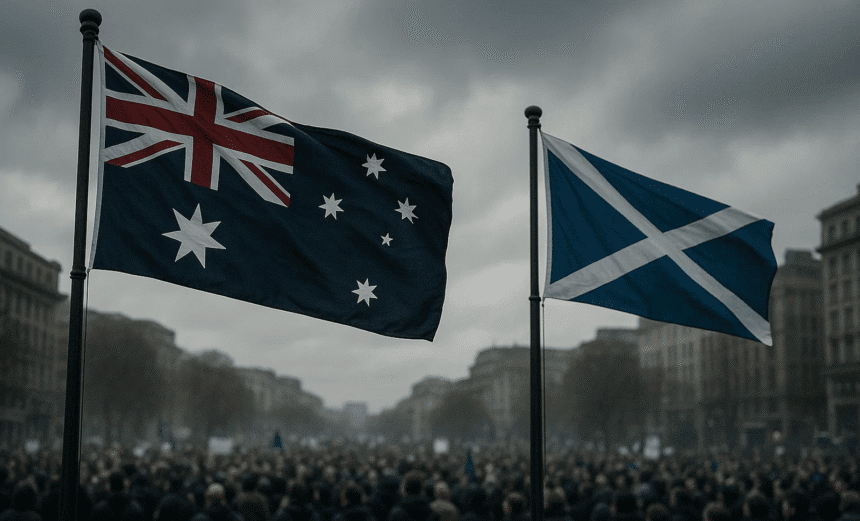On the weekend of Saturday, August 16, 2025, and Sunday, August 31, 2025, anger over immigration spilled onto the streets of Scotland and Australia, where nationalist groups and ordinary citizens staged coordinated demonstrations demanding stricter border controls and a reduction in refugee intake. In Scotland, protests erupted in Falkirk, Glasgow, Edinburgh, and Aberdeen, with demonstrators gathering outside George Square, the Scottish Parliament, and asylum seeker accommodations such as the Cladhan Hotel in Falkirk. Many carried banners reading “Send Them Home,” “Protect Our Borders,” and “Scots First,” while chanting against what they described as an “unsustainable influx” of refugees from the Middle East and Africa.
Their frustrations centered on the UK Home Office’s policy of relocating asylum seekers from England to Scottish towns, a move critics argue has overstretched already fragile housing and healthcare services. “We’re not against helping people, but our NHS is collapsing, housing is scarce, and yet politicians bring more in. Scots should come first,” one protester in Glasgow told reporters. The rallies, however, were not uncontested. Counter-demonstrations organized by faith groups and community activists took place under banners proclaiming “Refugees Welcome” and “No Human is Illegal.” Police maintained strict separation between the groups, making three arrests for disorderly conduct but reporting no serious violence.
Thousands of miles away, in Sydney, Melbourne, Brisbane, Perth, and Canberra, Australians staged marches on August 31 that mirrored the Scottish protests in tone and message. Branded the “March for Australia,” the events drew thousands of people carrying national flags and chanting “Aussie jobs for Aussies.” Demonstrators pointed to rising rents, overstretched public infrastructure, and stagnant wages, accusing migrants of contributing to a growing crisis. One Sydney organizer told the crowd, “This isn’t about hate. This is about survival. Our rents are through the roof, wages are stagnant, and yet migration numbers are climbing. Politicians must listen.”
Yet, these protests were also marked by a more radical edge. In Melbourne, extremist groups, including neo-Nazi factions, joined the demonstrations, raising alarm over far-right influence. Violence erupted when a contingent of marchers stormed Camp Sovereignty, a sacred Aboriginal protest site, leaving four people injured and sparking widespread condemnation. Police faced criticism for their delayed response to the attack, which many Indigenous leaders described as a worrying escalation of white supremacist activity.
As in Scotland, counter-movements quickly mobilized. In Sydney and Melbourne, multicultural advocacy groups staged colorful street festivals under the banner “We Are One,” showcasing music, dance, and food to highlight the contributions migrants have made to Australian society. For many attendees, these counter-demonstrations were as much about defending multiculturalism as they were about rejecting the growing influence of extremist groups within anti-migration circles.
Observers and analysts were quick to ask why these demonstrations had erupted almost simultaneously in different hemispheres. The answer, many argued, lies in mounting economic anxieties. Both the United Kingdom and Australia have faced surging housing costs, long waits for healthcare services, and persistent cost-of-living pressures. In Scotland, the Home Office’s relocation of asylum seekers has intensified a sense among locals that their communities are overwhelmed. In Australia, despite official statistics showing migration numbers have actually fallen by more than a third since 2022–23, the perception among many citizens is that immigration is spiraling out of control. As Dr. Fiona McKenzie, a political sociologist at the University of Edinburgh, explained, “These demonstrations are less about refugees themselves and more about broader frustrations, economic insecurity, distrust of government, and cultural fears.”
Government leaders responded swiftly but in contrasting tones. In Scotland, First Minister Humza Yousaf condemned the rallies as “shameful,” insisting that refugees enrich Scotland’s communities and deserve compassion rather than hostility. In Australia, Prime Minister Anthony Albanese struck a more cautious balance. While condemning the extremist presence at the marches, he acknowledged citizens’ concerns about housing and the cost of living, promising that migration settings would be constantly reviewed “to balance growth and fairness.” Both governments now face the political challenge of reconciling humanitarian commitments with rising public discontent, a balance made more precarious by the visible involvement of far-right elements.
The demonstrations in Scotland and Australia reflect a global surge of anti-migration sentiment. In Turkey, violent anti-Syrian riots broke out between June 30 and July 2, 2024, engulfing cities from Kayseri to Istanbul and leaving dozens injured. In Poland, public anxiety led to the reinstatement of border controls with Germany and Lithuania in July 2025, accompanied by vigilante patrols on the border. In Tunisia, residents of Jebeniana and El Amra staged protests against the presence of thousands of stranded sub-Saharan migrants, citing food and water shortages. Even in Mexico City, anti-gentrification rallies in mid-2025 took on xenophobic tones, with graffiti declaring “gringo go home” aimed at American tourists and digital nomads.
By the time night fell on both Glasgow and Sydney, the crowds had dispersed, but the underlying tensions remained unresolved. To some, the demonstrations represented a legitimate call for governments to prioritize citizens struggling with economic hardship. To others, they signaled a dangerous slide into xenophobia, stoked by extremist movements and misinformation. What is clear is that migration has become more than a parliamentary debate; it is now a battle fought in the streets, with voices for compassion and inclusion clashing directly with those demanding border walls and deportations. From Scotland’s historic squares to Australia’s bustling city centers, the echoes of “Send Them Home” reveal a global fault line that shows no sign of closing.


















